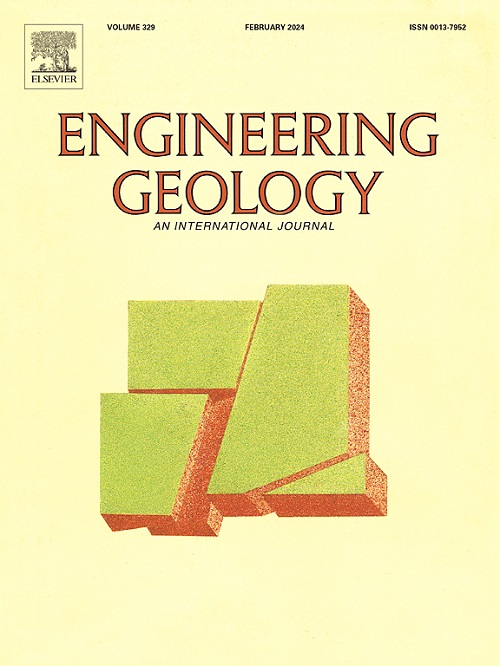A new semi–analytical method for elastic–strain softening circular tunnel with hydraulic–mechanical coupling
IF 6.9
1区 工程技术
Q1 ENGINEERING, GEOLOGICAL
引用次数: 0
Abstract
This study presents a novel coupled hydraulic–mechanical algorithm for analysing nonlinear seepage in circular tunnels with elastic strain softening characteristics. The model integrates porosity changes with permeability coefficients to formulate a set of nonlinear seepage equations. The Mohr–Coulomb criterion is used to determine the of rock stress yielding state, and the plastic strain is used as a softening parameter to assess the degradation of rock strength. The proposed model is validated through a comparison with established numerical and analytical solutions. The pore water pressure distribution exhibits a distinctive three-stage curve under coupling conditions, with the seepage behaviour transitioning to a classical Laplace-type equation as the coupling coefficient weights diminish. Parametric analysis reveals that the brittleness index is a pivotal factor governing the extent of the softening region. A decrease in residual strength intensifies strain softening, leading to a more extensive softening zone. Conversely, a reduction in the angle of internal friction affects only the rock's strength without altering the softening intensity. The study also demonstrated that the pore water pressure diminishes the effective stress within the rock mass, resulting in a larger plastic zone than that under dry conditions. Finally, internal reinforcement and external support can effectively mitigate the effects of strain softening and seepage on the stability of the surrounding rock.
水-力耦合圆形隧道弹性-应变软化半解析新方法
针对具有弹性应变软化特性的圆形隧道非线性渗流问题,提出了一种新的水力-力学耦合分析算法。该模型将孔隙度变化与渗透率系数相结合,建立了一套非线性渗流方程。采用Mohr-Coulomb准则确定岩石应力屈服状态,采用塑性应变εθp作为软化参数评价岩石强度退化。通过与已建立的数值解和解析解的比较,验证了所提模型的有效性。耦合条件下孔隙水压力分布呈现明显的三段式曲线,随着耦合系数权重的减小,渗流行为转变为经典的laplace型方程。参数分析表明,脆性指数β是控制软化区范围的关键因素。残余强度σc *的降低强化了应变软化,软化区扩大。反之,内摩擦角φ的减小只影响岩石的强度,而不改变软化强度。研究还表明,孔隙水压力降低了岩体内部的有效应力,导致岩体的塑性区比干燥条件下更大。最后,内部加固和外部支护可以有效缓解应变软化和渗流对围岩稳定性的影响。
本文章由计算机程序翻译,如有差异,请以英文原文为准。
求助全文
约1分钟内获得全文
求助全文
来源期刊

Engineering Geology
地学-地球科学综合
CiteScore
13.70
自引率
12.20%
发文量
327
审稿时长
5.6 months
期刊介绍:
Engineering Geology, an international interdisciplinary journal, serves as a bridge between earth sciences and engineering, focusing on geological and geotechnical engineering. It welcomes studies with relevance to engineering, environmental concerns, and safety, catering to engineering geologists with backgrounds in geology or civil/mining engineering. Topics include applied geomorphology, structural geology, geophysics, geochemistry, environmental geology, hydrogeology, land use planning, natural hazards, remote sensing, soil and rock mechanics, and applied geotechnical engineering. The journal provides a platform for research at the intersection of geology and engineering disciplines.
 求助内容:
求助内容: 应助结果提醒方式:
应助结果提醒方式:


